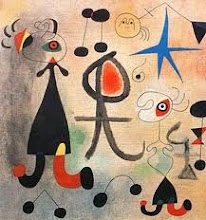What It Takes To Be Artistic
"Every child is an artist.
The problem is how to remain an artist once grown up."
-- Pablo Picasso
Introduction:
1. Children are naturally artistic, but can become discouraged or derailed as they grow up.
2. Educators may inadvertently dampen creativity without realizing it.
3. "Working with children makes you no more a teacher than having a piano makes you a pianist." Michael Levine (italics mine)
"Much education today is monumentally ineffective. All too often we are giving young people cut flowers when we should be teaching them to grow their own plants."
-- John Gardner
Key Question(s):
How do we promote student interest?
(or) What are common elements that can be identified among schools with strong arts
programs?
Four Considerations:
A. Reviewing/revising curriculum and teaching philosophy.
B. Integrating art history to the present experience.
C. Providing art units that students enjoy.
D. Across all grade levels reducing look-alike projects while increasing exploration, expression and experimentation (EEE)
A. Reviewing/revising curriculum and teaching philosophy.
1. Praxis: What is it? How does dichotomy endanger it?
“Praxis is practice… with thoughtfulness of reflection. It is as an idea emerged from Paulo Freire. Praxis embodies our belief that theory and practice are not opposites, but rather complements that work together to further one’s lifelong growth as an artist-educator.”
-- Steinhardt School of Culture in New York
Skills Based Spiral Model & Developmental Stages:
2. Visual Arts Spiral Model and Developmental Stages
a. As knowledge builds upon knowledge, so do concepts, skills and processes.
b. Developmental Stages:
o Scribbling (ages 2-4)
o Symbolic (ages 5-7)
o Realistic (ages 9 and up)
c. Drawing: Sample of Spiral Model in action:
Preschool : Exploration of lines, color and space
Elementary: Exploration of lines, color, space, overlapping, foreground, middle ground, and background
Middle School: Exploration of lines, color, space, overlapping, foreground, middle ground, background, linear perspective, depth, volume, illusion of space
High School: Exploration of lines, color, space, overlapping, foreground, middle ground, and background, linear perspective, atmospheric perspective, depth, volume, illusion of space, contour, highlight, halftone, shadow side, shadow edge, reflected light, movement,
rhythm, balance… etc
B. Integrating art history to the present experience.
Examples (accompanied by digital photos of student artwork):
Art Pictorials that forge an artistic style.
4th Grade Art History Unit:
Antoni Gaudí Dream Houses
C. Providing art units students enjoy.
Examples (accompanied by digital photos of student artwork):
o Prototype Models
o Miniature Sculptures
o Mural Design
o Synectics
o Wire Sculpture
o Creativity Theory
o Modern Character Pieces
o Food Replicas
o Stain Glass Window Design
o Faux Finishing
o Photo Montage
o Oxymorons
o Scary Things
D. Across all grade levels reducing look-alike projects while increasing exploration, expression and experimentation (EEE)
Examples (again… accompanied by digital photos of student artwork):
● Drawing with Brush ● Watercolor & Marker ● Color Chalk “Light on Dark
Conclusion:
Educators need to be updated, in tune and discerning what is best for each child to insure the maturing process in all areas (Illustration: green banana that never matures)
Subscribe to:
Post Comments (Atom)

No comments:
Post a Comment